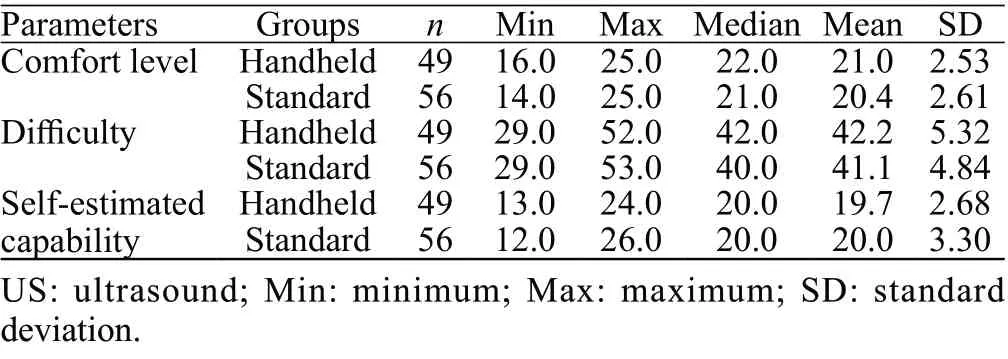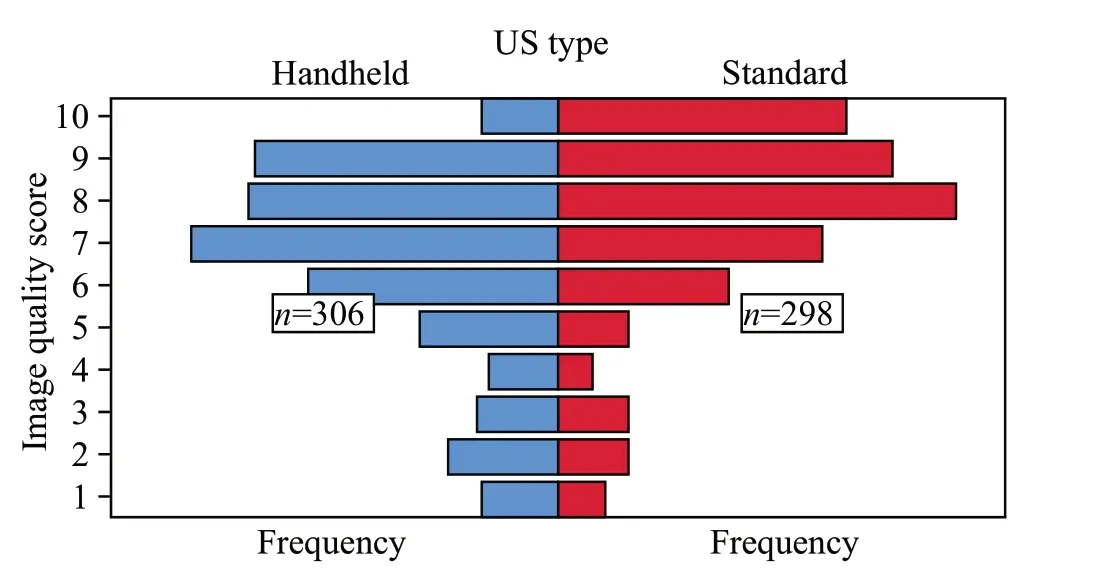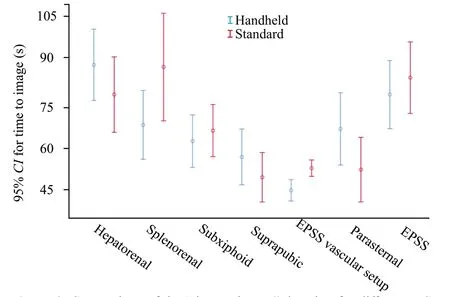A comparison of handheld and standard ultrasound in Swiss medical students
Mark Slader, Hayley Young, Margot Barker, Kylie Prentice, Katherine Bogaard, Charlene Yuan, Soheil Saadat, Shadi Lahham
1 School of Medicine, University of California, Irvine 92617, USA
2 Department of Emergency Medicine, University of California, Irvine 92868, USA
KEYWORDS: Handheld ultrasound; Ultrasound education; Switzerland; Medical education
INTRODUCTION
Point-of-care ultrasound (POCUS) has become a diagnostic mainstay in healthcare. Its ability to produce anatomical imaging in real time combined with its portability and lack of ionizing radiation exposure has led to its frequent use in clinical and educational applications.As a result, POCUS is now increasingly used in medical schools and residency programs across the United States.The growing use of POCUS within healthcare and medical education has inspired the development of new ultrasound(US) technology, and in the last decade, US machines have become more portable and affordable.Pocket-sized US devices are now widely available for physicians to use at bedside.Narula et alsuggest that the use of handheld US will lead to its incorporation as a portion of the standard patient physical exam, equating it to the use of a stethoscope. Evaluating pathology through bedside US could lead to more appropriate testing and diagnostic reasoning amongst medical students and residents. As this diagnostic technology improves, there is continued expansion into clinical medical education.
With recent innovations in handheld US equipment,standard three-probe US machines have been consolidated into a single probe capable of full-body imaging. Despite their convenient size and low price point, these products have not supplanted standard US machines for medical education purposes. While the use of standard US in medical education has been extensively studied and deemed beneficial to medical students in preclinical coursework,the learning outcomes of US education with handheld devices remain primarily unevaluated. As medical schools begin to incorporate US into their curriculum, it is important to determine the effectiveness of these devices as learning tools.
In 2016, the European Federation of Societies for Ultrasound in Medicine and Biology (EFSUMB)released a statement that “ultrasound should be used systematically as an easy, accessible, and instructive educational tool in the curriculum of modern medical schools”.The EFSUMB further stated the need for handheld US education and training in addition to acknowledging “there are currently no prospective trials investigating handheld US training”.Despite the EFSUMB’s continued promotion of US in European medical education, formal US education is still at its beginnings in medical schools across Europe.As a result, there has been a promotion of student-tutor-based training of US, such as the “Young Sonographers” of the Swiss Society of Ultrasound in Medicine.These programs have been well received in Swiss medical schools and have proved to be successful.Together,these circumstances allow for an environment conducive to assessing handheld US as a primary learning device in medical education.
To date, there have been no studies comparing the use of handheld US to standard US for medical education. The objective of this project is to determine whether an advanced handheld US device can provide a comparable primary learning experience to that of a standard US machine. We hypothesize there is no significant difference in a medical student’s ability to learn basic US techniques and obtain quality imaging when learning on a handheld US device rather than a standard US machine in an intensive US course.
METHODS
Study design
We performed a prospective observational study utilizing a convenience sample of participants recruited from the University of Basel Medical School between July 1, 2019 and July 25, 2019. The study spanned a period of four weeks with two full courses taking place each week. This study was approved by the Institutional Review Board (IRB) with the support of the University of Basel Medical School in Basel, Switzerland. Study participants were divided into two cohorts: those learning POCUS using standard US machines and those learning using handheld US. All instructions were provided in English.
Study protocol
Study participants were recruited via email sent out to medical students from the University of Basel,University of Zurich, and University of Bern. In Switzerland, medical education consists of six years of training immediately following completion of secondary school and completion of a qualifying examination.Study participants included students in various stages of their medical education. All research participants were provided with comprehensive information regarding the purpose and design of the study. Each participant voluntarily enrolled and provided verbal, informed consent. Participant privacy was protected by deidentifying all personal information using assigned,study-specific codes.
Courses were taught by allopathic medical students who had completed all mandated requirements of the first year of medical education. This included achieving passing grades in relevant courses such as physiology,anatomy, and basic POCUS. Additional US education included 12 h of hands-on training in small-group settings, as well as pre-recorded lecture content that taught POCUS imaging of the major organ systems.Lectures covered topics including US physics and knobology, cardiac, abdominal, hepatobiliary, renal,pulmonary, vascular, ocular, pelvic, and musculoskeletal US imaging. Students were evaluated with written examinations, observed competence in small-group settings, and a practical exam. All instructors were required to achieve a minimum of 70% for each system to pass the training course. Participating instructors also underwent an additional 4 h of hands-on preparation and training with the handheld and standard US machines with manufacturer representatives to ensure comfort and competency.
During the data collection period, one two-day course was taught per week on a standard US machine,and the subsequent two-day course was taught on the handheld US machines. Each course structure was identical aside from the US machines utilized per course. The US course focused on US principles of basic physics and instrumentation, pulmonary US, abdominal US, cardiac US, and the Focused Assessment with Sonography for Trauma (FAST). The course layout consisted of a 15-minute didactic lecture on each topic,followed by 30-60-minute extensive personal handson practice on each topic. The US principles, pulmonary US, abdominal US, and cardiac US lectures were given on the first day of the two-day course, with the FAST scan lecture given on the second day of the two-day course. Lectures were provided in PowerPoint format and included diagrammatic, video, pictorial, and textual content. Lectures and the practice components of the course centered on US orientation, probe selection,pathology, physiology, efficiency, image acquisition and optimization, and accuracy.
Our instructors hosted eight two-day US courses which alternated between teaching exclusively with the standard US machine and teaching exclusively with the handheld US machine. All other portions of the course,including didactics and examinations, were the same for each cohort. Instructors taught the same didactic lecture in English among all eight courses to maintain consistency among the cohorts. Each instructor manned a practice station during practice sessions following each didactic lecture, and participants rotated among the stations. Assessments on each day were administered by the same moderator among all eight courses to minimize instructor variation in grading. Assessments were administered at the second half of each day during hands-on practice. The order of students assessed was randomized. Day one assessment was cardiac focused.Participants were assessed on their ability to acquire parasternal long and short views, apical 4 and 5, and substernal views; as well as the ability to measure endpoint septal separation (EPSS) and tricuspid annular plane systolic excursion (TAPSE). Day two assessment centered on the FAST scan, measuring the efficiency and clinical utility of each view obtained. Surveys were filled out by participants of each cohort, following the conclusion of each two-day course.
Assessment
Participants were evaluated on their US abilities following the conclusion of each day’s didactics and hands-on practice sessions. Those assigned to the handheld US group completed their assessments using a Butterfly iQ probe (Butterfly Inc., Guilford, CT, USA),and those assigned to the standard US group completed their assessments using a Hitachi Arietta V70 ultrasound machine (Hitachi Corp, Chiyoda City, Japan).
Day one assessments consisted of a limited cardiac scan. Each participant was given 5 minutes to correctly capture an image of the parasternal long (PSL) view,measure EPSS, assess mitral valve function, and calculate left ventricular ejection fraction (LVEF). Time was recorded for the duration of setup, image capture,and EPSS measurement. If the participant was unable to complete the assessment within the allotted time frame, the evaluation ended, and any incomplete tasks did not receive a recorded time. Day two assessments focused on the FAST scan, which is commonly used to evaluate trauma patients for pathologic intraperitoneal fluid. Participants were given 10 minutes to correctly capture the hepatorenal, splenorenal, suprapubic, and subxiphoid views. Similar to Day one, the setup time and time to capture each image were recorded, and tasks not completed within the time limit did not receive a recorded time.
The images captured during these evaluations were ultimately graded by two emergency ultrasound-trained,board-certified emergency medicine physicians for picture quality, clinical utility, and whether the correct images were obtained. Clinical utility and whether the correct images were obtained were rated on a yes/no scale, and picture quality was rated on a 1-10 scale,with 1 being the lowest quality and 10 being the highest.Each participant captured and submitted a maximum of 5 images (PSL, hepatorenal, splenorenal, suprapubic,subxiphoid); those who were unable to correctly capture a view did not submit an image for that view.
At the end of each two-day course, participants were asked to complete a post-course survey that evaluated their experience with the assigned probe style (handheld US or standard US). Participants rated how difficult it was to correctly obtain each view, measure EPSS and TAPSE, and use various modes (motion mode [M mode],color mode, Doppler mode). They were also asked to rate their comfort using the assigned probe style and their confidence in performing each scan in the future.
Data collection and statistical analysis
Data from Day 1, Day 2, and post-course survey were all recorded and stored in REDCap, a secure data storage web application. A Chi-square test was used to compare the proportion of correctly obtained images and the proportion of images that were clinically useful between study groups. Picture quality scores between study groups were compared using an independentsamples Mann-Whitney-test. Data from the postcourse survey is represented by three composite variables reflecting 1) the comfort level of participants to find the correct view for US, 2) overall difficulty of obtaining different views, and 3) participants’ self-estimation of the capability to do US on their own in the future.The composite variables between study groups were compared by using the independent-samples Mann-Whitney-test. Type 1 error level was set to 5%.
RESULTS
One hundred and nighteen participants were included in data analysis. A total of 59 students from the standard US group captured 298 images, while a total of 60 students from the Handheld US group captured 306 images. Of the images captured by the standard US group, 260 (87.2%) were rated as correctly obtained,and 267 (89.6%) were rated as clinically useful. On the other hand, 256 (83.7%) of the images captured by the handheld US group were rated as correctly obtained, and 265 (86.6%) were rated as clinically useful. Between the two groups, there was no statistically significant difference in the percentage of correctly obtained images (=0.211) or the percentage of images that were clinically useful (=0.256). The median quality score of images obtained by the standard US group was 8(7.30±2.33) compared to 7 (6.50±2.37) in handheld US group (<0.01) (Figure 1).
Some study participants did not complete their experience survey at the completion of the study. Table 1 details the user experience with standard US versus the handheld US. There was no statistically significant difference in participants’ opinion on overall difficulty of obtaining different views (=0.198), their comfort level when obtaining different views (=0.188), and their self-estimated capability to perform US in the future(=0.442). The handheld US group was able to complete setup time for PSL & EPSS quicker than the standard group (=0.001).
Across all other measures, the 95%for both the handheld US group and the standard US group overlapped, indicating that there was no statistically significant difference between the performances of the handheld US group and the standard US group(Figure 2).
DISCUSSION
Our study aimed to evaluate whether a handheld US device can provide a comparable learning experience to that of a standard US machine for Swiss medical students. Our two-day educational US workshop was designed to teach the basics of POCUS through didactics and intensive hands-on practice with the cardiac,pulmonary, gastrointestinal/abdominal, and FAST scans.Among the two groups, our data suggest no significant difference in the participants’ ability to correctly find and identify the US views of abdominal, cardiac, and FAST US scans. Furthermore, our post-course surveydata demonstrated no significant difference in the participants’ rated difficulty, comfort, and confidence in their ability to perform US between the two different types of equipment. Our data suggests that a handheld US machine can serve as well as a standard US machine as a US educational tool.

Table 1. Qualitative experience survey - Handheld vs. Standard US group

Figure 1. The distribution of image quality score between the study groups. The median quality score of images obtained by the standard US group was 8 (7.30±2.33) compared to 7 (6.50±2.37) in the handheld US group (P<0.01). US: ultrasound.

Figure 2. Comparison of the “time to image” duration for different US studies in standard and handheld devices. There was no statistically significant difference in any of the “time to image” measurements,except for EPSS vascular setup time (P=0.001). EPSS: endpoint septal separation.
US has been increasingly utilized in medical education due to its enhancement of the physical exam and complement to anatomical learning. For this reason,some United States-based medical educators have begun to develop standardized US protocols for preclinical and clinical education.A 2012 survey by Bahner et alindicated 62.2% of United States medical school respondents had US training incorporated into their undergraduate medical education. In 2019, a survey of 168 United States accredited medical schools indicated that the number of schools with a US curriculum had risen closer to 72.6%.And in European medical schools, a 2016 survey showed that practical skills of US were taught in 56% of undergraduate medical universities; however, the mean number of hours of US instruction was only seven.The same survey indicated lack of funding as one of the primary obstacles to advancing existing programs.
Due to the contemporary state of US education in Switzerland,the University of Basel provided an environment of medical students with minimal to no previous US instruction. This allowed for a neutral assessment of the two different US modalities in medical students at varying stages of their education. With the continued growth of US education in medical schools across the United States, it was important to find students without prior US experience.
Due to its increasing popularity among clinicians and medical educators, US technology has continually advanced to meet its demand. As a result, newer and more portable products have been produced.Studies have shown that the increased use of pocket-sized US has produced beneficial clinical outcomes,and its routine use in the inpatient setting is cost-effective.However,while the handheld US has been extensively studied in clinical medicine, its practice and implementation into medical education have not.At a time when more research is needed regarding handheld US in medical education, our data demonstrate the noninferiority of a handheld US device when compared to a standard US machine. While the use of standard US is established within current United States medical education, our results suggest a handheld US device can potentially function as a more cost-effective and portable alternative.Combined with the benefit of increasing medical student exposure with handheld US to match its increased use in the clinical setting, these findings may inform medical educators’ decisions on which US probes are most effective and appropriate for students.
Limitations
Our study has several limitations. First, we included a convenience sample of Swiss medical students. The results found in this population may not be generalizable to students in the United States or other countries.Additionally, while no cultural or language barriers were noticed by the study team, some may have existed that prevented complete understanding of the educational material. Another limitation of the study was that handheld US assessment was done solely using Butterfly iQ probes vs. one standard US machine. Other handheld US devices and standard US equipment may require further study and comparisons due to the varied ease of use in different machines.
Further research is needed to evaluate the potential of handheld US devices in medical education. Largerscale studies examining additional aspects of handheld vs. standard machines could shed further light on their differences. Also, the vast price gap between the two machines should be investigated to explore the handheld’s cost-effectiveness in medical education.Lastly, new technology incorporating tele-guidance in US software is one promising point of exploration that could help expand US education. Finally, research is needed to elucidate how handheld US education translates to clinical practice.
CONCLUSIONS
Our data suggest that there is no statistically significant difference in Swiss medical students’ ability to correctly find and identify the US views of abdominal,cardiac and FAST US scans using a handheld US device when compared to a standard US device. Furthermore,our post-course survey data demonstrate no significant difference in the participants’ rated difficulty, comfort,and confidence in their ability to perform US between the two different types of equipment. Although our data indicate that handheld US image quality are rated lower than images collected by standard US, this metric do not impact the clinical utility of the images.
None.
This study was approved by the Institutional Review Board (IRB) with the support of the University of Basel Medical School in Basel, Switzerland. Each participant provided verbal, informed consent before participating in the study.
There are no financial or other conflicts of interests related to this article.
MS, HY, MB, KP, KB, and CY: concept, study design, and data collection. SL: IRB proposal submittal and study design. SS: data analysis and image construction. All authors contributed to manuscript development and revision.
